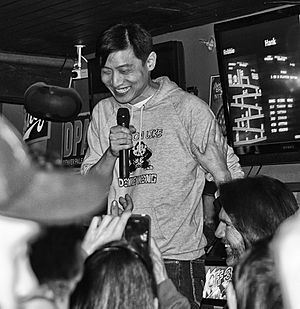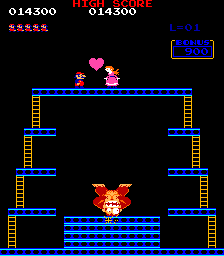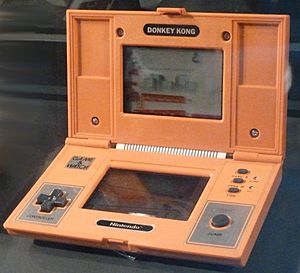Donkey Kong (arcade game) facts for kids
Quick facts for kids Donkey Kong |
|
|---|---|
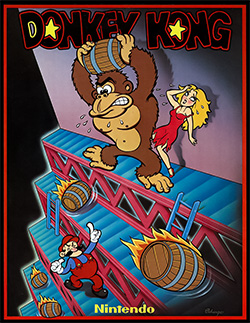
North American arcade flyer
|
|
| Developer(s) |
|
| Publisher(s) | Nintendo |
| Director(s) | Shigeru Miyamoto |
| Producer(s) | Gunpei Yokoi |
| Designer(s) |
|
| Artist(s) | Shigeru Miyamoto |
| Composer(s) | Yukio Kaneoka |
| Series | Donkey Kong |
| Platform(s) |
|
| Release date(s) |
|
| Genre(s) | Platform |
| Mode(s) | Single-player |
| Arcade system | Radar Scope |
Donkey Kong is a super famous arcade video game that came out in 1981. It was made by Nintendo. In the game, you play as a character named Jumpman, who later became known as Mario. Your goal is to run, jump, and climb ladders up a construction site. You need to rescue a character named Pauline from a giant gorilla called Donkey Kong.
This game was the very first in the Donkey Kong series. It was also the first time Mario ever appeared in a video game! Donkey Kong was created because Nintendo wanted a big hit game, like Pac-Man, to become popular in North America. Hiroshi Yamauchi, who was the president of Nintendo, gave the job to Shigeru Miyamoto. It was Miyamoto's first time designing a video game.
Miyamoto got ideas from stories like Beauty and the Beast and old movies like Popeye and King Kong. He worked with engineer Gunpei Yokoi to create the game's story and design. They did something new by using graphics to show what characters were like. The game also had short animated scenes (called cutscenes) to help tell the story. Plus, it was one of the first games to have many different stages to play through.
Even though some people at Nintendo in America were worried at first, Donkey Kong became a huge success. It was popular in Japan and North America. It earned the most money of any arcade game in 1981 and 1982. The game was also made for other systems like the Game & Watch, selling millions of copies. Nintendo even let another company, Coleco, make versions for home consoles, which also sold millions.
Many companies tried to copy the game, but Nintendo stopped them. The characters from Donkey Kong became very popular. You could find them on breakfast cereal, toys, and even in TV cartoons. A movie studio tried to sue Nintendo, saying Donkey Kong was too much like their movie King Kong, but Nintendo won the case.
The success of Donkey Kong helped Nintendo become a very powerful company in the gaming world for many years. Mario, who first appeared in this game, became Nintendo's main character and one of the most famous characters in the world. Donkey Kong also helped create the platform game style of games. It's known as one of the most important games from the golden age of arcade video games and one of the most popular arcade games ever.
Contents
How to Play Donkey Kong
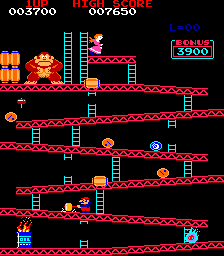
Donkey Kong was one of the first platform games, even before that name was used. People used to call them 'climbing games'. It was the first platform game where you could jump. This meant players had to jump over gaps, obstacles, and enemies. This idea became super important for all future platform games. Donkey Kong was also very advanced for its time because it had four different stages. Most arcade games back then only had one stage.
Besides saving Pauline, your goal is to get a high score. You earn points for:
- Jumping over things.
- Breaking objects with a power-up hammer.
- Collecting items like hats, umbrellas, and purses.
- Removing special rivets from platforms.
- Finishing each stage quickly, which gives you bonus points.
You start with three lives. You get an extra life if you reach 7,000 points. You lose a life if Mario touches Donkey Kong or an enemy, falls too far, or runs out of time. The game ends when you lose all your lives.
Each of the four stages shows Mario climbing higher up the construction site: 25, 50, 75, and 100 meters.
- In the first stage, Mario climbs crooked beams and ladders. He must jump over or smash barrels and oil drums that Donkey Kong throws.
- The second stage has you climbing a five-story building with conveyor belts that move cement pans.
- In the third stage, you ride elevators and dodge bouncing springs.
- The last stage requires Mario to pull out eight rivets from the platforms holding Donkey Kong. When all are gone, Donkey Kong falls, and Mario finally reunites with Pauline.
These four stages make up one full level. After you finish a level, the stages repeat, but they get harder. For example, Donkey Kong throws barrels faster, and sometimes they bounce diagonally. The game gets tougher and faster as you play more levels. There's even a "kill screen" on level 130, where a small error in the game's code makes Mario lose a life quickly, ending the game.
High Score Battles
People love to compete for the highest scores in Donkey Kong. A movie called The King of Kong: A Fistful of Quarters (2007) showed the efforts of Steve Wiebe trying to beat the world record. At that time, Billy Mitchell was thought to hold the record.
In the early 2010s, Hank Chien set a new record of 1,138,600 points. Later, Robbie Lakeman broke that record. Then, John McCurdy set a new record in 2021 with 1,272,700 points. Just five months later, Robbie Lakeman got the record back by scoring 100 more points than McCurdy!
There are other world record challenges for Donkey Kong too. One popular one is the "No Hammer Challenge." Players try to get the highest score without using the hammer power-up. The current record for this challenge is 735,100 points, set by Jeff Wolfe in 2008.
The Story of Donkey Kong
Donkey Kong is one of the first video games to tell a story that you can see happening on the screen. The game takes place at a construction site in New York City. The main bad guy is the gorilla, Donkey Kong. The hero is a carpenter, who was first called Jumpman and then later named Mario. Donkey Kong kidnaps Mario's girlfriend, who was first called Lady and then renamed Pauline. As the player, you control Mario and must rescue her. This idea of a hero saving someone in trouble became very common in many video games that came after Donkey Kong.
The game uses its graphics and animations to show what the characters are like. Donkey Kong makes a mean face when Mario loses a life. Pauline wears a pink dress and has long hair, and she cries "HELP!" in a speech bubble. Mario wears red overalls and a red cap. His design was made to work with the limited graphics of the time. His mustache helps show his mouth, his cap means they didn't have to animate hair, and his colored overalls make his arm movements clear.
Like Pac-Man, Donkey Kong has short animated scenes (cutscenes). But Donkey Kong was special because these scenes actually moved the story forward. The game starts with the gorilla climbing ladders to the top of a construction site. He drops Pauline and stomps his feet, bending the steel beams. He then moves to his spot and sneers. This short animation sets the scene and adds to the game's story. After each stage, a heart appears between Mario and Pauline, but Donkey Kong grabs her and climbs higher, breaking the heart. The story ends when Mario reaches the end of the rivet stage. He and Pauline are finally together again, and a short celebration plays.
How Donkey Kong Was Made
In 1980, Nintendo of America started, but they weren't doing very well. In early 1981, the president, Minoru Arakawa, made a big order for 3,000 Radar Scope arcade machines. But the game didn't sell well in America, leaving 2,000 machines sitting in a warehouse. Arakawa asked Nintendo's president in Japan, Hiroshi Yamauchi, for a new game to put into these machines. Yamauchi asked everyone at the company for new game ideas to help save the struggling American branch.
This is how Shigeru Miyamoto got his first chance to design a game. He came up with the idea for Donkey Kong. Yamauchi made Gunpei Yokoi the project supervisor.
Nintendo also wanted to make a game based on the Popeye comic strip, but they couldn't get the rights. So, Nintendo decided to create their own new characters that they could use in many games. Miyamoto thought of a story about a gorilla, a plumber with a big hammer, and a girlfriend. This was like the rivalry between Bluto and Popeye for Olive Oyl. Bluto became an ape, who Miyamoto said was "nothing too evil." Miyamoto said that Beauty and the Beast and the 1933 King Kong movie were also inspirations. Donkey Kong was one of the first times a video game's story was created before the game was programmed.
Yamauchi wanted the game to be popular in North America, so he said it needed an English name. Miyamoto decided to name the game after the ape, who he thought was the strongest character. There are different stories about how "Donkey Kong" got its name. One story says Miyamoto looked in a Japanese-English dictionary for a word that meant "stubborn gorilla." "Donkey" was meant to mean "silly" or "stubborn," and "Kong" was a common Japanese slang for "gorilla." Miyamoto said in 2001 that he thought the name would make people think of a "stupid ape."
Miyamoto had big hopes for his new game. He wasn't a programmer, so he talked to engineers to see if his ideas could be made. He wanted characters of different sizes with different movements. Yokoi thought Miyamoto's first design was too complicated. Miyamoto then thought of using sloped platforms, barrels, and ladders. When he said the game would have multiple stages, the programmers complained because it was like making many games in one. But they followed Miyamoto's plan, creating about 20 kilobytes of game content. Yukio Kaneoka created the music for the levels and story parts.
The circuit boards from the unsold Radar Scope machines were changed to make Donkey Kong. The game's look and gameplay were updated for new memory chips, but the main computer parts, sound, and screen stayed the same. Mario and other moving objects used single sprites (small images), while Pauline used two, and Donkey Kong used six.
The game was sent to Nintendo of America for testing. The sales manager didn't like it because it was so different from the maze and shooting games that were popular then. But Arakawa strongly believed it would be a hit. American staff translated the story for the arcade machine art and named the characters. They named the Lady "Pauline" after Polly James, the wife of Nintendo's warehouse manager. Arakawa suggested changing "Jumpman" to "Mario" after Mario Segale, the landlord of Nintendo of America's first office. These names were put on the American arcade machines and used in ads. Donkey Kong was ready to be released!
Two bar managers in Seattle, Washington, agreed to try out Donkey Kong machines. They were unsure at first, but when they saw the games earning $30 a day for a week, they asked for more! At Nintendo's headquarters, a small team took apart 2,000 Radar Scope machines and put in the Donkey Kong parts from Japan. The game officially went on sale in July 1981.
Bringing Donkey Kong to Players
Game console makers were very interested in Donkey Kong. Nintendo said no to a big offer from Taito. Then, Coleco and Atari also wanted to make versions of the game. In the end, Yamauchi gave Coleco the special right to make Donkey Kong for home consoles and tabletop games. He thought Coleco was "the hungriest company" and would do a good job marketing it. Nintendo got a payment and extra money for each game cartridge and tabletop unit sold.
Coleco sold the game with its new ColecoVision console, which came out in August 1982. Coleco also made versions for the Atari 2600 and Intellivision. The Atari 2600 version was made by Garry Kitchen. He had only a few months to make it and had to leave out two of the original game's four levels because of the Atari 2600's limited memory. Coleco's sales quickly doubled after Donkey Kong was released. Coleco also released small tabletop arcade versions of Donkey Kong in 1982.
Donkey Kong on NES
Nintendo also made a version of Donkey Kong for their own Family Computer (Famicom) console. It was released in Japan on July 15, 1983, as one of the first three games for the system. The Famicom console was designed to be able to play Donkey Kong very well. This version was later released in North America and Europe for the Nintendo Entertainment System (NES). The NES version had to leave out the cement factory stage and most of the cutscenes because early game cartridges didn't have enough memory. It did add a new song for the title screen. Both Donkey Kong and its sequel, Donkey Kong Jr., were included in a game collection called Donkey Kong Classics in 1988.
Donkey Kong on Game Boy
A completely new version of the original arcade game was made for the Game Boy in 1994. It was simply called Donkey Kong. This game included levels from both the original Donkey Kong and Donkey Kong Jr. arcade games. It started with the same four levels as the arcade game, but then it added 97 more puzzle-based levels! It was also one of the first games to have special features for the Super Game Boy system.
Hidden Secrets in the Atari Version
The Atari 8-bit computer version of Donkey Kong had one of the longest-hidden "Easter eggs" in video game history. The programmer, Landon Dyer, hid his initials in the game. They would appear if the player lost a life under certain conditions and then went back to the title screen. This secret wasn't found for 26 years until Dyer mentioned it on his blog!
Donkey Kong's Big Impact
Donkey Kong led to many other games where you run, jump, and climb up levels. This was a new type of game. At first, people called these games "Donkey Kong-type" or "Kong-style" games. Later, this type of game became known as platform games. The game was also a big step forward in how video games told stories and used cutscenes. While some earlier games had a story or cutscenes, Donkey Kong was special because it used cutscenes to show a full story unfolding. It also had many different levels that helped move the story along.
Donkey Kong was one of the first Japanese games to come to Western countries that had a unique, cute art style. This was common in Japanese fantasy but new to Western players. Because of this, Donkey Kong and similar games were sometimes called "novelty games." These games helped Western audiences get used to Japanese game design and storytelling, which became very important in the years that followed, especially with the release of the Famicom/NES.
Computer and Video Games magazine called Donkey Kong the "most important" game released in 1981. It introduced three big names to the video game world: Nintendo, Shigeru Miyamoto, and Mario. These three people played a huge role in video game history. Donkey Kong also helped pave the way for the Nintendo Entertainment System (NES). After Donkey Kong was so successful, Nintendo started making the Famicom (NES). The console's design was based on the Donkey Kong arcade machine, aiming to have strong graphics like the arcade game.
Playing Donkey Kong Today
The NES version of Donkey Kong has been re-released many times. You can unlock it in the GameCube game Animal Crossing. It's also available on Virtual Console for the Wii, Wii U, and Nintendo 3DS. The original arcade version of the game even appears in the Nintendo 64 game Donkey Kong 64, and you have to beat it to finish that game! Nintendo also released the NES version on the Nintendo e-Reader and for the Game Boy Advance as part of the Classic NES Series.
In 2004, Namco released an arcade machine that included Donkey Kong, Donkey Kong Jr., and Mario Bros.. There's also a special version called Donkey Kong: Original Edition that adds back the cement factory stage and some missing animations from the original NES version. This special edition has only been released on the Virtual Console. The original arcade version was also re-released for the Nintendo Switch in 2018.
Games Like Donkey Kong
Donkey Kong was one of the most copied video games in the early 1980s. Many games tried to be like it. By 1983, there were many Donkey Kong copies available for different home systems.
Some copies, like Crazy Kong, were even officially allowed by Nintendo for certain countries. But other copies were illegal. These illegal copies sometimes had names like Konkey Kong or Donkey King. Nintendo took legal action against companies selling these copies. For example, the 1982 Logger arcade game was a direct copy of Donkey Kong, but it had a big bird instead of an ape and rolling logs instead of barrels.
Many home computer copies also used the gorilla theme, like Killer Gorilla and Killer Kong. Other games changed the characters, like Cannonball Blitz, which had a soldier and cannonballs.
Nintendo tried to stop these unauthorized copies and won many lawsuits. They estimated they lost a lot of money because of these copied games.
More Donkey Kong Games
Donkey Kong led to a sequel called Donkey Kong Jr. (1982). In that game, you play as Donkey Kong's son, trying to save his father from Mario!
In 1983, the spin-off game Mario Bros. came out. This game introduced Mario's brother, Luigi. It was a cooperative game set in a sewer and started the whole Mario game series.
Also in 1983, Donkey Kong 3 was released. This game was a shooting game where a character named Stanley had to get rid of the ape and insects from a greenhouse.
Nintendo brought back the Donkey Kong series in the 1990s with new platform games made by Rare. The first of these was Donkey Kong Country in 1994.
In 2004, Nintendo released Mario vs. Donkey Kong, where Mario has to chase Donkey Kong to get back stolen Mini-Mario toys. In the next game, Mario vs. Donkey Kong 2: March of the Minis, Donkey Kong falls in love with Pauline again and kidnaps her. Mario then uses the Mini-Mario toys to help rescue her.
There are also music-based Donkey Konga games that use special bongo controllers. Donkey Kong Jungle Beat (2005) is a unique platform game that also uses the bongo controller.
In 2007, Donkey Kong Barrel Blast was released for the Nintendo Wii. The Donkey Kong Country series was brought back by Retro Studios with Donkey Kong Country Returns in 2010 and Donkey Kong Country: Tropical Freeze in 2014.
Donkey Kong also appears in the Wii U game NES Remix. This game takes parts of old NES games and "remixes" them into new challenges. For example, one challenge has Link from The Legend of Zelda trying to save Pauline in the Donkey Kong level, but Link can't jump!
The game is also featured in Super Smash Bros. Brawl and Super Smash Bros. for Wii U, which include a demo of the NES version and a stage based on the "75m" level from Donkey Kong.
Donkey Kong in Pop Culture
By mid-1982, Donkey Kong was so popular that over 50 companies wanted to use its characters for products. Mario and Donkey Kong appeared on cereal boxes, board games, pajamas, and even Japanese comics (manga). In 1983, a cartoon called Donkey Kong was made for the Saturday Supercade TV show. In the cartoon, Mario and Pauline chase Donkey Kong, who has escaped from the circus, while solving mysteries.
The game has also been mentioned in movies and documentaries. The 2007 movie The King of Kong is about people trying to get the world record high score in Donkey Kong. This movie even inspired Hank Chien to start playing the game, and he later became a world champion. The story of the game's creation and the lawsuit with Universal were talked about in an episode of High Score on Netflix.
In the 2015 movie Pixels, aliens turn into 1980s arcade characters, and the alien leader becomes Donkey Kong in the final battle. In The Super Mario Bros. Movie (2023), Charles Martinet (Mario's voice actor in the games) has a small role as Guiseppe, who looks like Mario from the original Donkey Kong game. Guiseppe is also seen playing Donkey Kong on an arcade machine, but in the movie, the game is called "Jump Man," which was Mario's original name.
Songs like "Do the Donkey Kong" and "Donkey Kong" were released in 1982. Other artists have mentioned the game in their songs. Episodes of TV shows like The Simpsons, Futurama, and The Fairly OddParents have also referenced the game. The sound effects from the Atari 2600 version are often used as general video game sounds in movies and TV. The phrase "It's on like Donkey Kong" was made popular by rapper Ice Cube in 1992 and is now used in many parts of popular culture. Nintendo even applied for a trademark on this phrase in 2010.
See also
 In Spanish: Donkey Kong (videojuego) para niños
In Spanish: Donkey Kong (videojuego) para niños


